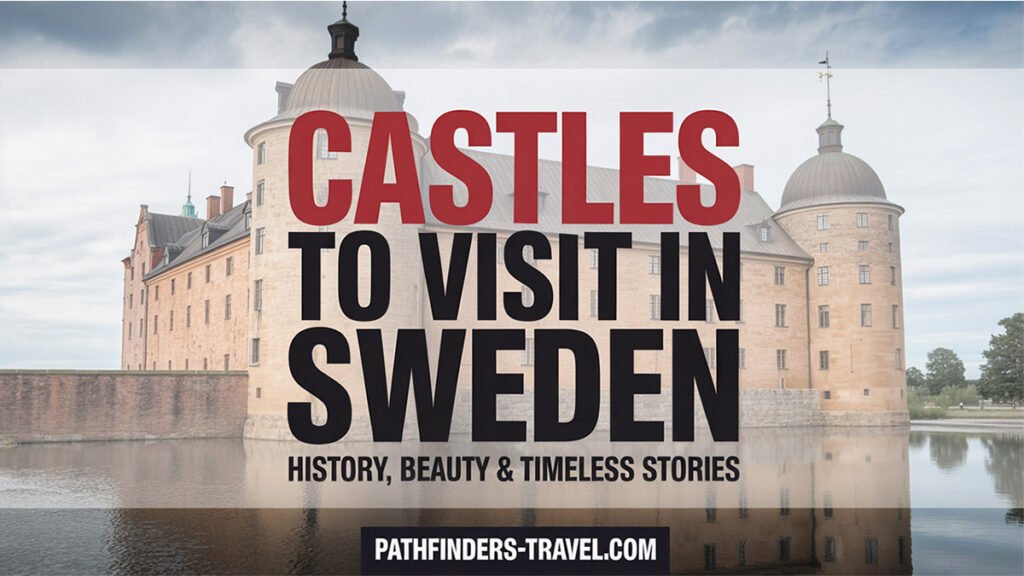Estimated reading time: 19 minutes
Key Takeaways
- Sweden’s castles offer a fascinating journey through medieval and Renaissance architecture, from 13th-century fortresses to elegant royal residences
- Örebro Castle stands as one of the best castles to visit in Sweden, with its striking 13th-century origins and strategic location on the Svartån River
- The dramatic ruins of Borgholm Castle on Öland island tell the story of a fortress that transformed into a grand palace before fire claimed it in 1806
- Kalmar Castle played a crucial role in Scandinavian history as the site of the 1397 Kalmar Union agreement
- Malmö Castle now houses a fascinating museum complex covering art, history and natural sciences
Table of Contents
- Introduction
- Overview of Sweden’s Castles
- Örebro Castle – A Medieval Jewel
- Borgholm Castle Ruins on Öland – Echoes of Royal Legacy
- Kalmar Castle – A Sentinel of Scandinavian History
- Malmö Castle – Blending History with Modern Attractions
- Additional Recommendations and Tips
- Frequently Asked Questions about Medieval Castles in Sweden
- Conclusion
Introduction
Sweden’s landscape is dotted with historic castles that stand as enduring monuments to its rich medieval heritage, royal history, and the beautiful blend of architecture and nature. These storied structures not only reveal tales of kings, queens, and legendary battles, but they also showcase Sweden’s unique natural beauty—from tranquil rivers to sweeping island landscapes. Setting out to discover the best castles to visit in Sweden promises an adventure that combines the thrill of exploration with immersive history, offering visitors unforgettable sights, stories, and atmospheres that capture the essence of this Nordic nation.
Want to see this for yourself? Click here to jump to the video in UHD 4K Resolution.
Overview of Sweden’s Castles and Historical Role in Culture
Castles have played a vital role in shaping Swedish culture throughout the centuries. These magnificent structures have served various purposes over time—from defensive fortresses protecting strategic trade routes to lavish royal residences showcasing the wealth and power of monarchs. Today, they stand as important historical sites that allow visitors to step back in time and witness Sweden’s rich heritage firsthand.
The architectural evolution of Swedish castles tells its own fascinating story. Early medieval structures focused primarily on defense, featuring thick stone walls, imposing towers, and strategic positions often surrounded by water. As threats of invasion diminished over time, castles transformed into more comfortable and ornate palaces, with Renaissance and Baroque influences bringing elegant facades, grand staircases, and lavish interiors designed to impress rather than intimidate.
When visiting Sweden’s historic castles, you can expect comprehensive guided tours that reveal hidden chambers and secret passages, exhibitions that showcase period furnishings and royal artifacts, and stories that bring to life the characters who once walked these hallowed halls. Many castles also host seasonal events, from medieval festivals to classical concerts, adding another dimension to your visit.
Sweden’s rich medieval heritage and fortress tradition has significantly shaped its cultural landscape. The country’s castles not only served defensive purposes but also functioned as administrative centers and symbols of royal authority throughout the centuries. [SOURCE]
Örebro Castle – Medieval Stronghold and Tour Guide
Introduction to Örebro Castle
Örebro Castle stands as one of the most prominent medieval strongholds in central Sweden, with origins dating back to the late 13th century. Historians believe it was possibly constructed by Birger Jarl, one of Sweden’s most influential medieval leaders, to protect vital trade routes through the region. The castle’s strategic location—perched on a small island in the Svartån River—enhances its imposing presence while providing natural protection from potential attackers.
This fortress has witnessed centuries of Swedish history, evolving from a simple defensive structure to an elegant royal residence. Its distinctive silhouette, characterized by four round corner towers, has become an iconic symbol of Örebro city and ranks high on the list of best castles to visit in Sweden.
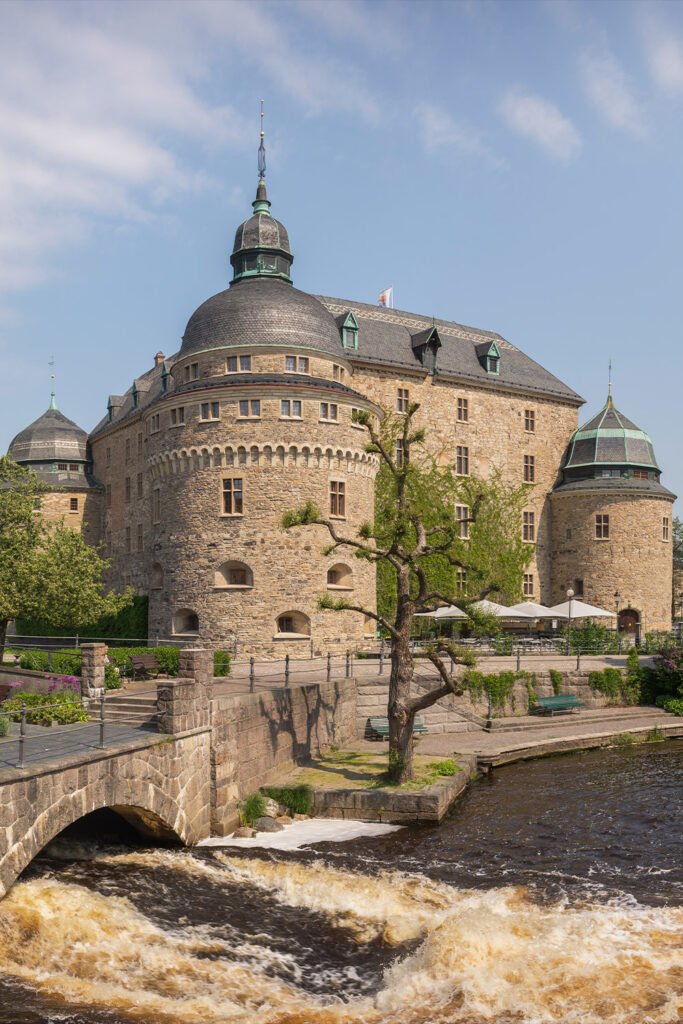
Örebro Castle Tour
An Örebro Castle tour offers visitors a chance to step back in time and experience the fortress’s rich history firsthand. Guided tours take you through grand halls and winding staircases, revealing both the castle’s military significance and its later role as a royal residence. Particularly noteworthy are the secret passageways and ancient dungeons that speak to the castle’s strategic importance throughout Swedish history.
Architecturally, the castle showcases several impressive features, including its Renaissance towers added during the 16th century under King Charles IX, who significantly expanded and modernized the fortress. The castle’s great hall now serves as a venue for cultural events and exhibitions, allowing visitors to appreciate the space in a contemporary context while honoring its historical significance.
History enthusiasts will appreciate the castle’s museum collections, which include period furniture, weapons, and artifacts that illustrate life within these walls across different eras. Many visitors find the historical reenactments particularly engaging, as costumed interpreters bring the castle’s past inhabitants to life through stories and demonstrations.
Historical Intrigue
The walls of Örebro Castle hold countless stories of sieges, political intrigue, and royal drama. During the turbulent times of Swedish history, the castle withstood numerous attacks and changed hands between warring factions. One of its most famous historical episodes occurred during the Danish-Swedish conflicts of the 16th century, when the castle served as a crucial defensive stronghold.
Adding to the castle’s mystique are tales of its legendary prisoners, including Erik XIV, who was reportedly imprisoned here after being deposed as king. Visitors often hear about the various ghosts said to haunt the castle’s corridors, including the “White Lady” whose apparition is rumored to appear on stormy nights.
Örebro Castle’s historical significance extends beyond military conflicts. It also played a crucial role in Swedish governance, hosting parliamentary meetings and royal councils that shaped the nation’s history. Today’s visitors can walk the same halls where crucial political decisions were once made, creating a tangible connection to Sweden’s past. [SOURCE]
If you’re interested in exploring other historic European destinations, consider visiting the hidden paradises of the United Kingdom, which offer their own remarkable castles and landscapes.
Borgholm Castle Ruins on Öland – History, Scenery, and Visitor Tips
Historical Journey
The Borgholm Castle ruins on Öland stand as a haunting testament to Sweden’s dynamic royal history. Originally constructed in the 12th century as a defensive stronghold, the castle protected the strategic waters of the Kalmar Strait, which separates the island of Öland from mainland Sweden. Over the centuries, this fortress underwent dramatic transformations, evolving from a medieval military bastion into a grand Baroque palace.
Under the guidance of architect Nicodemus Tessin the Elder in the 17th century, Borgholm Castle was reimagined as a magnificent royal residence reflecting the power and prestige of the Swedish monarchy. However, fate had other plans—a devastating fire in 1806 gutted the structure, leaving behind the impressive limestone ruins that visitors explore today.
The castle’s historical significance is deeply intertwined with Sweden’s royal lineage. King Karl X Gustaf used Borgholm as a base during military campaigns, while later monarchs viewed it as a symbol of royal authority on the island. Though the castle never regained its former glory after the fire, its ruins became a romantic symbol of Sweden’s past, inspiring artists, poets, and today’s visitors alike.
Dramatic Scenery
What makes Borgholm Castle particularly captivating is its dramatic setting. The ruins stand majestically atop a limestone plateau, surrounded by open meadows and grasslands that create a stark, beautiful contrast to the weathered stone walls. This elevated position offers visitors panoramic views across Öland and the glistening Baltic Sea beyond.
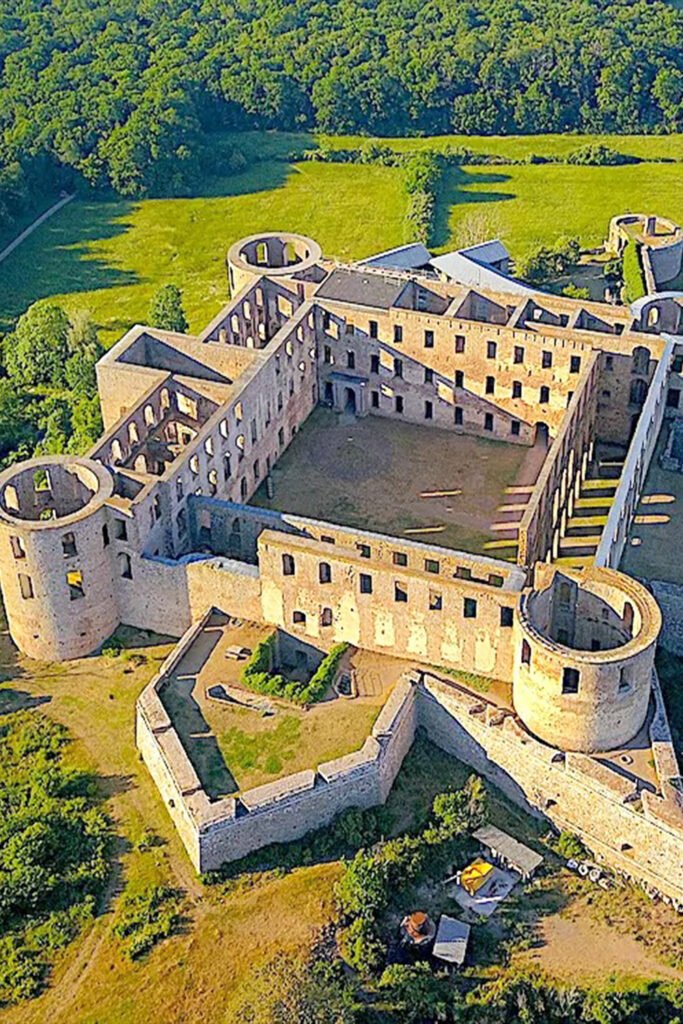
Photographers often visit at sunrise or sunset when the golden light bathes the limestone in warm hues, creating an almost ethereal atmosphere. The castle’s broken walls and empty window frames frame perfect vistas of the surrounding landscape, with each season bringing its own character to the scene—from wildflower-covered meadows in summer to fog-shrouded ruins in autumn.
The interplay between nature and the historic ruins creates a uniquely Swedish experience, where the country’s natural beauty and cultural heritage merge in a single breathtaking location. Birds nest in the crumbling towers, while wildflowers push through cracks in the ancient stones, symbolizing nature’s gentle reclamation of human construction.
Visitor Tips
When exploring Borgholm Castle ruins, wear comfortable, sturdy shoes as the terrain can be uneven. Allow at least two hours to fully appreciate the extensive grounds and the various vantage points throughout the ruins. Information panels throughout the site provide historical context in multiple languages, but guided tours (available during summer months) offer deeper insights into the castle’s fascinating past.
Just a short distance from Borgholm Castle lies Solliden Palace, the summer residence of the Swedish royal family. Many visitors combine tours of both sites for a comprehensive view of Öland’s royal heritage, spanning from medieval times to the present day. The palace gardens are particularly lovely and provide a manicured contrast to the wild beauty of the castle ruins.
The castle hosts various cultural events throughout the summer, including concerts and theatrical performances with the dramatic ruins as a backdrop. Check the official website before your visit to see if any special events coincide with your trip. For the best experience with fewer crowds, consider visiting in late May or early September when the weather remains pleasant but peak tourist season has passed.
For those interested in exploring other European destinations with rich historical sites, Italy’s hidden gems offer similarly impressive ruins and castles set in stunning landscapes.
Kalmar Castle – Renaissance Fortress and Union History
Historical Significance
Few Swedish castles can match the historical importance of Kalmar Castle, whose sturdy walls have witnessed pivotal moments in Scandinavian history. The castle’s most significant historical contribution came in 1397 when it hosted the signing of the Kalmar Union, a landmark agreement that united the crowns of Denmark, Norway, and Sweden under a single monarch. This union, which lasted over a century, fundamentally shaped Nordic politics and remains a crucial chapter in Kalmar Castle history.
The fortress occupies a strategically vital position on Sweden’s southeastern coast, guarding the narrow strait between the mainland and the island of Öland. This location made Kalmar a key defensive point and an important trading hub throughout the medieval period. During the numerous conflicts between Denmark and Sweden, control of Kalmar Castle often determined which kingdom held power in the region.
Under the rule of the Vasa dynasty in the 16th century, particularly during the reign of King Gustav Vasa and his sons, Kalmar Castle transitioned from a purely military installation to a symbol of royal authority and architectural innovation. The castle bears witness to Sweden’s emergence as a major European power during this period.
Architectural Grandeur
Kalmar Castle stands as one of the best-preserved Renaissance castles in Northern Europe, with an architectural evolution that spans several centuries. Its earliest incarnation began as a simple defensive tower in the 12th century, but the structure we see today largely dates from the 16th century when extensive renovations transformed it into an elegant royal residence.
One of the castle’s most distinctive features is its moated setting, with water surrounding the fortress on all sides, connected to land by a single bridge—a design that offered substantial protection against attackers. The exterior presents an imposing sight with its robust curtain walls, rounded corner bastions, and decorative Renaissance gables that combine military functionality with artistic flair.
Inside, visitors discover the castle’s dual nature—both fortress and palace. The royal apartments feature beautifully preserved interiors, including the spectacular Golden Hall with its ornate ceiling and the King’s Chamber with period furnishings. These rooms showcase Swedish Renaissance design, with influences from other European courts adapted to Scandinavian tastes and traditions.
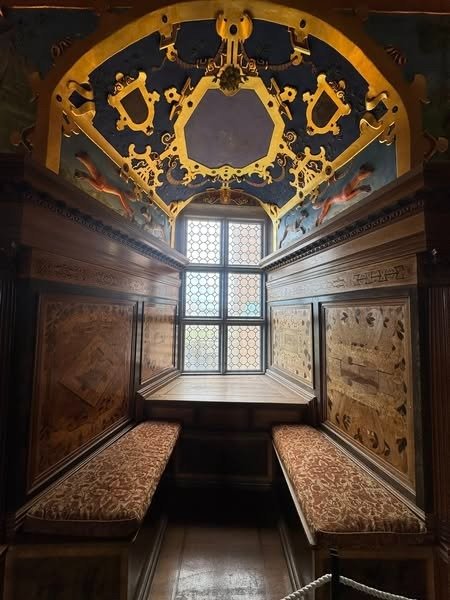
Visitor Experience
Today, Kalmar Castle offers an immersive historical experience through interactive exhibitions that bring its past to life. The castle museum features impressive collections of weapons, furniture, and artifacts that tell the story of life within these walls across different centuries. Particularly notable is the exhibition on the Kalmar Union, which uses modern technology to explain this complex historical period in an accessible way.
Guided tours provide fascinating insights into both the political history and daily life of the castle. Many visitors highlight the knowledgeable guides who share lesser-known stories about the castle’s inhabitants and events. For families, the castle offers child-friendly activities, including treasure hunts and costume opportunities that engage younger visitors with history.
For the most atmospheric experience, time your visit to coincide with one of the castle’s historical reenactments or seasonal events. The summer medieval festival is particularly popular, featuring period crafts, music, and demonstrations of historic combat techniques. During winter, the Christmas market held in the castle courtyard creates a magical experience with local crafts and traditional Swedish holiday treats.
If you’re fascinated by historic castles and looking to explore more destinations with rich cultural heritage, consider Japan’s amazing historical sites, which offer a fascinating contrast to European castle architecture.
Malmö Castle – Museum Guide and Castle Garden Walks
Museum Introduction
Malmö Castle, or Malmöhus as it’s known locally, has reinvented itself over the centuries—from a 16th-century fortress to one of southern Sweden’s most comprehensive museum complexes. Built in 1434 and later reconstructed in Renaissance style in the 1530s, this historic structure now houses the Malmöhus museums, offering visitors a diverse cultural experience that spans art, history, and natural sciences.
The castle’s transformation into a multi-faceted museum began in the 1930s, and today it encompasses several distinct collections. The Malmö Museum of Art showcases both Swedish and international works, with particular strength in Nordic painting from the 19th and 20th centuries. The City Museum portion details Malmö’s evolution from medieval trading port to modern urban center, while the Natural History Museum features impressive displays of Nordic wildlife and geological specimens.
What makes a visit to Malmö Castle particularly interesting is how it connects the region’s past to present-day issues. Exhibitions often examine historical events through contemporary lenses, encouraging visitors to see connections between past and present. The castle itself tells the story of the region’s shifting identities—it was originally built when Skåne (Scania) was part of Denmark, making it an important symbol of the area’s complex cultural heritage.
The Malmö Castle museum guide available at the entrance offers detailed information about the various collections and helps visitors navigate this extensive complex. For a deeper understanding of the exhibits, consider joining one of the guided tours offered in several languages.
Visitor Tips
When planning your visit to Malmö Castle, it’s helpful to know that the museum is open year-round with extended hours during summer months (June through August). A typical visit takes about 2-3 hours if you want to explore all sections, though many visitors choose to focus on areas that align with their specific interests.
For the best experience, start with the castle’s history museum to understand the building’s own story before exploring the specialized collections. The castle’s courtyard and surrounding moat are attractions in themselves, offering excellent photo opportunities and peaceful spots to rest between museum visits.
Families with children will appreciate the castle’s kid-friendly approach, with interactive elements throughout many exhibitions. The aquarium section, featuring species from Nordic waters, is particularly popular with younger visitors. During school holidays, the castle often hosts special activities and workshops designed specifically for children.
Just outside the castle lies the beautiful Castle Garden (Slottsträdgården), a lovely place for a stroll after your museum visit. This community garden project showcases organic gardening practices and offers a café serving fresh, seasonal food—perfect for lunch or an afternoon fika (coffee break).
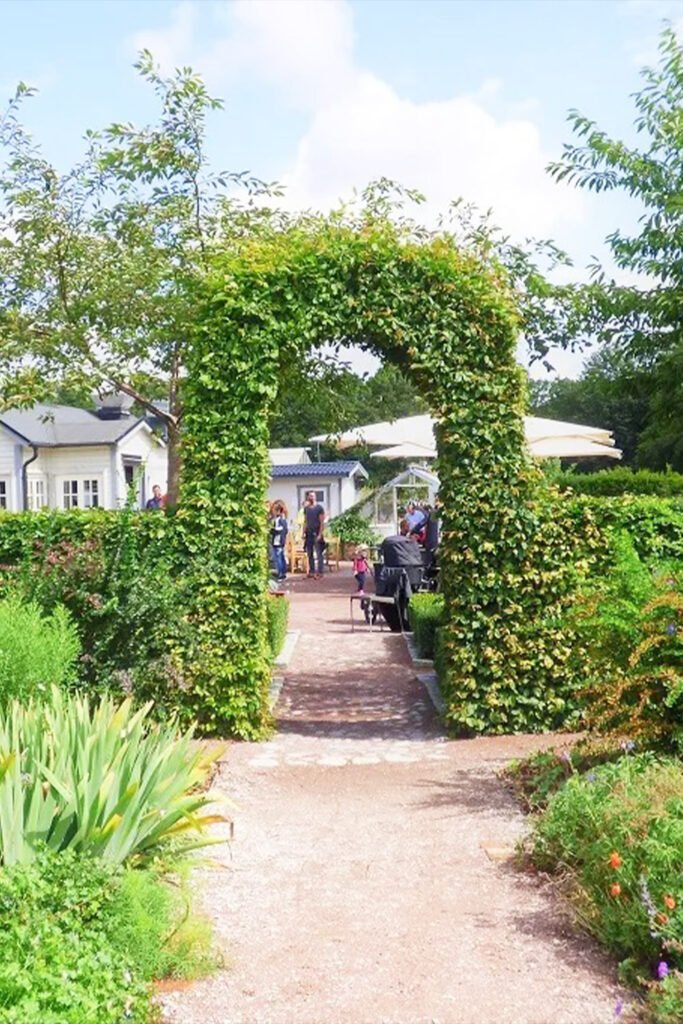
The castle is easily accessible from central Malmö, either by a pleasant 15-minute walk from the main square (Stortorget) or via public transportation. Combining your castle visit with exploration of the adjacent Kungsparken (King’s Park) and the historic district makes for an ideal day in Malmö.
For international travelers, it’s worth noting that Malmö’s proximity to Copenhagen (just across the Öresund Bridge) makes it possible to include the castle in a day trip from Denmark or as part of a broader Scandinavian itinerary. Many visitors find that the hidden gems of Canada offer similarly engaging historical sites and museums worth exploring on future travels.
Additional Castles in Sweden and Travel Tips
Further Castle Recommendations
While the castles featured above represent some of the finest historical landmarks in Sweden, several other magnificent structures deserve mention for travelers seeking to extend their castle-hopping adventure.
Gripsholm Castle, located in Mariefred about an hour from Stockholm, stands as one of Sweden’s best-preserved Renaissance castles. Built by Gustav Vasa in the 1500s, it houses the National Portrait Gallery with over 4,000 works spanning 500 years of Swedish history. The castle’s picturesque setting on Lake Mälaren, complete with a deer park, makes it particularly photogenic.
Drottningholm Palace, a UNESCO World Heritage site, serves as the permanent residence of the Swedish royal family. Often called “Sweden’s Versailles,” this 17th-century palace features magnificent gardens, a unique court theater still using original 18th-century stage machinery, and a Chinese Pavilion. Located just outside Stockholm, it’s easily accessible by boat or public transportation from the city center.
Vadstena Castle, with its impressive moat and Renaissance architecture, offers visitors a glimpse into 16th-century Swedish military engineering. Originally built by Gustav Vasa as a fortress to protect Sweden from Danish invasion, it later became a royal residence. Today, it houses a provincial museum and hosts summer concerts and events in its courtyard.
For those interested in more unusual castle experiences, Läckö Castle on Lake Vänern presents a striking white baroque structure with an excellent summer opera program, while Tjolöholm Castle near Gothenburg offers a surprising Tudor-style manor house with Arts and Crafts influences.
Visiting Tips
When planning your Swedish castle tour, consider these practical tips to enhance your experience:
- Seasonal considerations: Most castles are open year-round, but many offer extended hours and additional activities during summer (June-August). Winter visits (November-March) often mean fewer crowds but potentially limited access to certain areas or reduced tour schedules.
- Festival timing: Many castles host medieval festivals, Christmas markets, or cultural events throughout the year. Check official websites before planning your trip to coincide with these special occasions, which bring history to life through reenactments, period music, and traditional crafts.
- Culinary experiences: Enhance your castle visits by sampling local Swedish cuisine at nearby restaurants or castle cafés. Many feature traditional dishes using seasonal ingredients, offering a taste of regional specialties that complement the historical experience.
- Photography tips: Most castles permit photography without flash in their interiors, but specific rules may apply in certain rooms or exhibitions. Early morning or late afternoon light typically provides the most dramatic exterior shots, especially for ruins like Borgholm.
- Transportation: While some castles are accessible by public transportation, renting a car offers the most flexibility for visiting multiple sites, especially those in rural areas. Consider a regional focus rather than attempting to cover castles across the entire country in a single trip.
For travelers who enjoy historical architecture and beautiful landscapes, Switzerland’s hidden travel destinations offer similar appeal with their mountain châteaux and medieval towns.
Frequently Asked Questions about Visiting Castles in Sweden
What is the best season to visit castles in Sweden for tours and events?
The best season to explore Sweden’s castles is from late spring to early autumn (May–September), when tours, events, and outdoor walks are most accessible.
How much time is needed for a castle tour in Sweden?
Most castles require at least two hours to explore thoroughly, especially guided tours with exhibitions and seasonal activities.
Are Swedish castles family-friendly for tours and activities?
Yes, many castles in Sweden are family-friendly, offering guided activities, museum sections, and safe outdoor grounds for children.
How can visitors reach Sweden’s most famous castles by train, bus, or car?
Accessibility depends on the castle’s location, with many accessible by train or bus, while others like Borgholm Castle are best reached by car.
Do Swedish castles require entry fees, and are guided tours worth booking?
Most castles require an entry fee, often with reduced prices for children, students, and seniors, and guided tours are recommended for deeper context.
Conclusion
Visiting the best castles in Sweden provides both a journey into medieval and Renaissance history and an encounter with the country’s cultural identity. From Örebro Castle’s fortified towers to Borgholm’s windswept ruins on Öland, each site illustrates a different chapter of Swedish life and politics. Kalmar Castle, with its role in the Kalmar Union, highlights the country’s influence in Nordic history, while Malmö Castle shows how historic structures continue to serve communities through museums and cultural programs.
These sites are not only monuments of stone but also records of daily life, governance, and artistic achievement. Exploring them offers insight into how Sweden balanced defense, royal authority, and cultural expression over the centuries.
For travelers building broader itineraries, castles can be combined with regional landscapes such as the Scandinavia fjords or Sweden’s historic towns. Together, they provide a fuller perspective on how geography and history have shaped this Nordic nation.
We invite you to share your own experiences of Swedish castles in the comments below, and to continue your virtual explorations of world wonders by visiting Pathfinders Travel YouTube channel, where you can watch travel documentaries in stunning 4K resolution.

